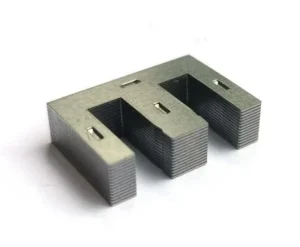
What is a Laminated Core?
Definition and Purpose
A laminated core is made up of thin layers (laminations) of ferromagnetic material, typically silicon steel, stacked and bonded together. The primary purpose of this design is to reduce eddy current losses, which occur when a changing magnetic field induces circulating currents within the core material. By laminating the core, the path for these currents is broken up, significantly reducing their magnitude and thus minimizing energy loss and heat generation.
Key points:
- Material Composition: Usually silicon steel or other ferromagnetic materials.
- Lamination Thickness: Thin layers typically ranging from 0.2 mm to 0.35 mm to effectively reduce eddy currents.
- Bonding Method: Layers are bonded using varnish or adhesive, or mechanically fastened to maintain structural integrity while maintaining electrical insulation between layers.
Common Applications in Industry
Laminated core is essential in a variety of electrical and electronic devices due to their efficiency and performance benefits. Some common applications include:
Transformers: Used in power distribution and electrical isolation, laminated cores help in reducing energy losses and improving the efficiency of transformers.
- Power Transformers: Utilized in electrical power distribution networks.
- Distribution Transformers: Used in local electrical distribution.
- Instrument Transformers: Applied in measuring and protection systems.
Electric Motors: In motors, laminated cores are used in both the stator and rotor to enhance performance and reduce heat losses.
- AC Motors: Induction motors and synchronous motors.
- DC Motors: Brushed and brushless DC motors.
Key Factors in Choosing Laminated Core
Material Selection
- Properties: High electrical resistivity, low hysteresis loss, and good magnetic permeability.
- Advantages: Cost-effective, widely available, and suitable for a broad range of applications.
- Disadvantages: Higher core losses compared to advanced materials like amorphous metals.
- Properties: Very high electrical resistivity and low coercivity, resulting in significantly reduced eddy current and hysteresis losses.
- Advantages: Extremely efficient, with much lower core losses compared to silicon steel.
- Disadvantages: More expensive and challenging to manufacture.
Ferrites:
- Properties: High magnetic permeability and electrical resistivity, suitable for high-frequency applications.
- Advantages: Ideal for RF applications and EMI suppression.
- Disadvantages: Brittle and less mechanically robust compared to metallic cores.
Nickel-Iron Alloys (e.g., Permalloy):
- Properties: Extremely high magnetic permeability and low coercivity.
- Advantages: Ideal for precision applications requiring sensitive magnetic properties.
- Disadvantages: More expensive and limited to specialized uses.
Impact on Performance and Efficiency
- Magnetic Permeability: High permeability materials (e.g., nickel-iron alloys) provide better magnetic coupling and efficiency.
- Electrical Resistivity: Higher resistivity materials (e.g., ferrites, amorphous metals) reduce eddy current losses.
- Hysteresis Loss: Materials with low coercivity (e.g., amorphous metals) exhibit lower hysteresis losses, enhancing efficiency.
Core Design and Shape
How Design Affects Functionality
E-Cores:
- Functionality: Concentrate magnetic flux effectively, providing good magnetic coupling in transformers and inductors.
- Applications: Ideal for power transformers and inductors requiring efficient magnetic paths.
U-Cores:
- Functionality: Provide a closed magnetic path with strong magnetic coupling.
- Applications: Suitable for current transformers and certain choke coils.
I-Cores:
- Functionality: Used in combination with other cores to form complete magnetic circuits.
- Applications: Often paired with E-cores in transformer designs.
- Functionality: Offer a closed-loop magnetic path with minimal leakage flux and high efficiency.
- Applications: Ideal for high-frequency transformers, inductors, and EMI suppression components.
Selecting the Right Shape for Your Application
- Transformers: E-cores or U-cores for power transformers; toroidal cores for high-frequency applications.
- Motors: Laminated stators and rotors typically use E-cores and I-cores.
- Inductors: Toroidal cores for compact and efficient designs; E-cores for general-purpose inductors.
Manufacturing Quality
Importance of Precision in Manufacturing
- Tight Tolerances: Ensuring precise lamination thickness and stacking reduces eddy current losses and improves magnetic performance.
- Quality Control: Consistent quality checks during manufacturing ensure the cores meet specified performance criteria.
- Bonding Techniques: Proper bonding of laminations (varnish, adhesive, or mechanical fastening) maintains core integrity and performance.
Standards and Certifications to Look For
- ISO 9001: Quality management system standard ensuring consistent manufacturing quality.
- UL Certification: Ensures safety and performance standards are met for electrical components.
- IEC Standards: International standards for electrical equipment ensuring global compatibility and performance.
By carefully considering these key factors, engineers and designers can select laminated core that best meets the performance, efficiency, and reliability requirements of their specific applications.